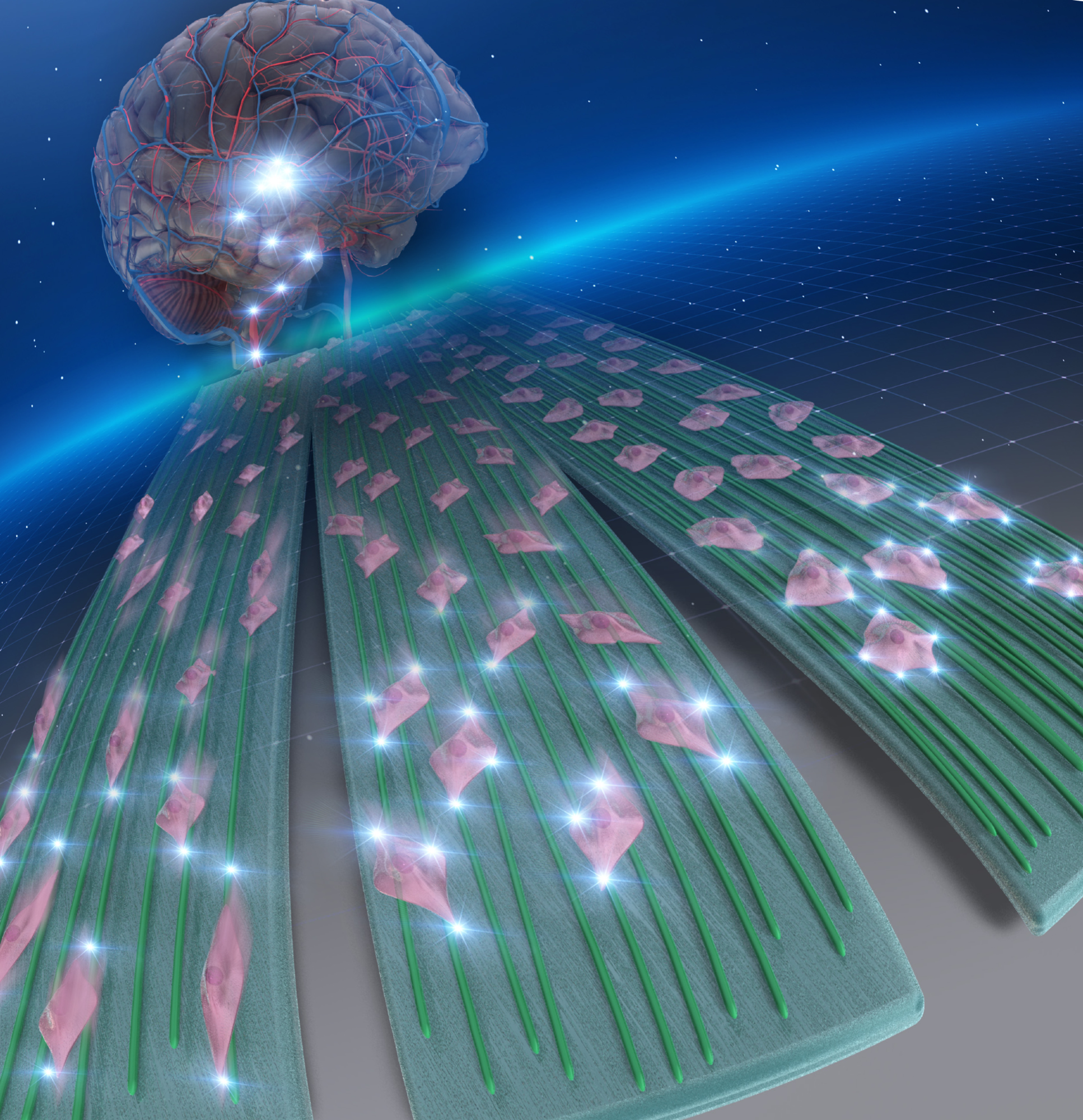Gaining control over the spread of a brain tumor is very hard and it is always resistant to traditional treatment methods. Thus, the prediction of tumor cell behavior needs a better understanding of their invasion mechanism.
 Glioblastoma multiforme (GBM) is an aggressive brain tumor that spreads along the white matter tracts of the brain. Now, researchers at the University of Fukui, Japan, have managed to engineer nanofibers mimicking the brain that can stop them from spreading. Image credit: Cover for ACS Applied Bio Materials Vol. 4 No. 10, reused with permission from American Chemical Society.
Glioblastoma multiforme (GBM) is an aggressive brain tumor that spreads along the white matter tracts of the brain. Now, researchers at the University of Fukui, Japan, have managed to engineer nanofibers mimicking the brain that can stop them from spreading. Image credit: Cover for ACS Applied Bio Materials Vol. 4 No. 10, reused with permission from American Chemical Society.
Currently, scientists from the University of Fukui, Japan, have employed high-density nanofibers that tend to simulate the brain’s microenvironment to capture such tumor cells. This paves the way to novel therapeutic solutions for aggressive brain cancer.
Essential replacement of damaged cells with the new cells helps the human body heal its injuries. The new cells always tend to migrate to the site of injury through a process called “cell migration.” But abnormal cell migration can also assist the transport and spread of cancer cells inside the body. Glioblastoma multiforme (GBM) is known to be one such example of a highly invasive brain tumor that spreads through the migration of the tumor cells.
The frequencies at which such tumor cells tend to spread and grow make traditional tumor removal methods ineffective. Also, options like chemotherapy and radiotherapy are detrimental to healthy cells and induce adverse effects. An accurate understanding of the invasion mechanism of GBM cells is required for the development of enhanced therapeutic strategies.
An alternative treatment strategy includes capturing the migrating tumor cells. It has become apparent that cell migration is governed by the structure and the orientation of the “extracellular matrix” (ECM) — that is, fibrous structures encircling the cells. Designing similar structures of preferred geometries will help gain control over the migration process.
Recently, in a study published in the ACS Applied Bio Materials journal, scientists from the University of Fukui, Japan, have developed a new platform depending on nanofibers that mimic the ECM to analyze their effect on GBM cells.
We fabricated a nanofibrous sheet in which the fiber density changes from end to end gradually using a technique called ‘electrospinning’ and carried out a culture experiment of brain tumor cells.
Dr. Satoshi Fujita, Study Head, Department of Advanced Interdisciplinary Science and Technology, Graduate School of Engineering, University of Fukui
Distinct differences were noted by the researchers in cell movement in nanofibers of various densities. Also, they identified that the denser fibers encouraged the development of so-called “focal adhesions” clusters in the cells that led to slower cell migration.
Taking advantage of this negative correlation between cell movement and fiber density, the scientists were able to regulate and direct the migration of cells by developing a nanofibrous sheet with gradually changing densities.
They organized the fibers in a high-to-low density configuration and thus limited the movement of cells as the majority of them were caught in the high-density zones. By contrast, a low-to-high density configuration exhibited the opposite effect and promoted migration.
Moreover, the researchers observed that the gaps present between the zones impeded cell migration, resulting in cells being locked up in the high-density zones. This single-way migration was noted initially by the researchers and referred to as “cell trapping,” after fish and insect traps that induce their prey to travel along a single direction prior to trapping it.
The study demonstrates the feasibility of capturing migrating cells using electrospun nanofibers that mimic the microenvironment of the brain.
Dr. Satoshi Fujita, Study Head, Department of Advanced Interdisciplinary Science and Technology, Graduate School of Engineering, University of Fukui
The team is thrilled by their exceptional findings and are excited to see what the future hold for their nanofiber-based platform.
It is available for the design of scaffolding materials, which are the basis of regenerative medicine, in combination with various fiber processing technologies and material surface treatment technologies.
Dr. Satoshi Fujita, Study Head, Department of Advanced Interdisciplinary Science and Technology, Graduate School of Engineering, University of Fukui
“This could lead to the development of practical applications of regenerative medicines, In addition, it can be used as a processing technology for culture carriers for efficient production of biological drugs including proteins, antibodies, and vaccines,” concluded Fujita.
Journal Reference:
Huang, W.-Y., et al. (2021) Cell Trapping via Migratory Inhibition within Density-Tuned Electrospun Nanofibers. ACS Applied Bio Materials. doi.org/10.1021/acsabm.1c00700.